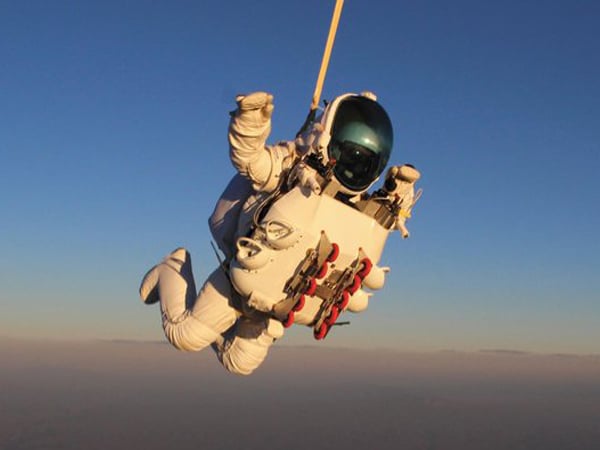I did one jump, May 4th, 1986, from 3000' altitude above the airfield (so c. 3900' above sea level).
The aircraft was a Cessna (172, I think) with all seats but the pilot's removed - a single-engined high-winged monoplane with fixed gear and diagonal struts from the wings down to low on the fuselage.
The door was on the starboard side of the aircraft, top-hinged, and swung up to clip onto the bottom of the wing to provide clear egress.
There were six of us aboard - the pilot, the jumpmaster, and four rookie skydivers.
I asked to go first, stating quite honestly that I was likely the most scared.
I stepped onto the starboard landing-gear housing, grabbed the strut, and went out hand-over-hand until I was well clear of the fuselage. I was hanging at perhaps 45°, buffeted by the wind. I remember thinking "This is a pretty cool movie", because it certainly didn't seem quite real.
I let go when the jumpmaster said to. I had wondered about the possibility of colliding with the tailplane, but almost immediately saw the aircraft way above me. It looked like it had hardly moved forward.
Immediately after that I saw a blue streamer thing originating behind me and going way over my head. I realized it was the parachute, deployed automatically by the static line.
The 'chute blossomed, and I descended for about 3 minutes. The 'chute was old-school, completely round, but I had some control by pulling the risers.
As warned, I noticed trees and buildings increasing in size exponentially, and instead watched the horizon as instructed. (The idea is that if you know when you're going to hit the ground, you tense up and are more likely to get injured.) I kept both feet together as instructed.
Thus, the landing caught me by surprise, as intended, and I didn't sprain an ankle.
It was a great experience, but once was enough.
I had had a terrible fear of heights from early childhood, which had caused me a lot of shame over the years, and this was an attempt to deal with it. $180 of "therapy" in 1986 dollars. About 10 hours gross wage at the time?
It was fairly successful, as I'm OK on ladders and going on my roof now. Not thrilled, but can do it.
P. S. At the time I worked in a large telecom manufacturing plant. The environment was pretty coarse, with many of the techs being heavy drinkers and using a lot of profanity.
I went in for the dayshift Monday, and said to one of my coworkers, a good guy, "Hey, if I went skydiving, would you go too?"
"Yeah, sure, as soon as you do. Ha!"
I unbuttoned my collared shirt to show off my "I made my first parachute jump in Carman Manitoba" t-shirt underneath. My friend responded with an obscenity and something like "I would, but the wife would kill me".






